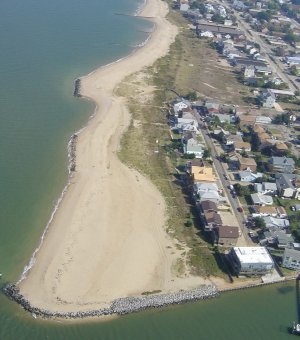The chairman of the state’s coastal rule-making panel expressed confidence in an Army Corp of Engineers led-permitting process for small jetties called terminal groins along the N.C. coast.
Bob Emory, chairman of the N.C. Coastal Resources Commission, said yesterday that the decision to forgo new state rules for the structures and rely on a process led by the Corps was the right call. He was responding to questions about the process raised in a letter to the commission from the N.C. Coastal Federation.
Supporter Spotlight
 Bob Emory |
A bill passed by the N.C. General Assembly in 2011 cleared the way for groins, the first permanent, hardened structures allowed on the N.C. beaches since 1985. The law, however, contains a number of environmental and financial conditions that projects must meet. How to ensure that those conditions are met and how the structures will be monitored and any damage they cause mitigated have been the subjects of a simmering debate.
The Corps is currently considering environmental studies for proposed groins at Figure 8 Island and Ocean Isle Beach.
In its recent letter to the commission, the federation maintained that the state Division of Coastal Management does not have the proper authority to issue or deny groin permits in part because it did not develop separate rules for them.
The letter also raises concerns about how long-term financial costs and potential damages would be handled and it urges the CRC to reconsider its decision not create specific rules for the groins.
Emory said he and Braxton Davis, the division director, plan to set up a meeting with federation representatives to discuss the concerns, but that for now the division is satisfied with the Corps’ process. To receive its needed federal permit and to meet one of the requirements of the state law, sponsors of groin projects have to complete a detailed study of possible environmental effects of the groins and other alternatives. The Corps leads the process for a so-called environmental impact statement in consultation with several state and federal agencies, including the Division of Coastal Management.
Supporter Spotlight
The division, Emory said, has a mandate to move forward with a permitting process for the groins. “Because of the legislation, the division has to move along,” he said. “If we find that somewhere along the way we need to do rule-making, we can do that.
“I think it’s a choice,” Emory said. “Doing this through a multi-agency review as opposed to doing it through rule-making. That’s the dilemma.”
 The terminal groin at Willoughby Spit near Norfolk, Va. Photo: Virginia Institute of Marine Science. |
He said the CRC continues to see no need to go to a rule-making process for the groins. “Certainly at this point the coastal commission doesn’t think so,” he said.
Emily Hughes, who is leading the Corps’ work on developing the study for the groin projects, agreed with the CRC’s approach. In an email response, Hughes said she disputes the assertion that the state has not gone through adequate rule-making for the projects. “The state does have rules in place for the terminal groins. It’s called Senate Bill 110,” Hughes wrote.
She said extensive long-term monitoring of the groins will be in place to determine if they’re working properly.
The bill was the result of a compromise hammered out between coastal legislators and Gov. Bev Perdue in the 2011 session. Although it breaks with long-held state policy against harden structures, the law allows only terminal groins defined in the law as “a structure that is constructed on the side of an inlet at the terminus of an island generally perpendicular to the shoreline to limit or control sediment passage into the inlet channel”— and set the cap of four projects.
The bill also lays out a general set of guidelines for judging the efficacy of a project and requires an inlet management plan, beach re-nourishment at the location, a monitoring plan, mitigation in the event of adverse impacts and a bond or other financial assurance to cover the costs of long-term maintenance and restoration of any public or private property damaged by adverse effects.
The yearlong process to complete the environmental study starts with “scoping meetings,” which offer the public the first glimpse of the project and the process and allows people to suggest issues that should be considered in the study.
Last month, in response to a scoping meeting for the proposed terminal groin at Ocean Isle Beach, the federation sent the Corps a harsh critique of the process. In a letter to Hughes, the federation’s Mike Giles and Ana Zivanovic-Nenadovic raised several concerns including whether there will be a solid exploration of alternatives and how the effectiveness of the project will be monitored should a groin be built.
The two said even the official description of the project seems to anticipate that the groin will be chosen as the preferred option.
 Mike Giles |
“The project description is troublesome in that the applicant clearly states its preferred alternative before any alternatives have been thoroughly investigated and discussed during the formal EIS process,” they wrote. “Clearly other alternatives must be evaluated, and non-structural alternatives may be much more practical once the total benefits and costs of this project are more fully understood.”
Giles pointed to inlet channel relocation projects at North Topsail Beach and at Mason and Bogue inlets as examples of working alternatives to groin projects.
Giles said the law is a start but falls far short of what the state would normally do in the case of a major modification to the Coastal Area Management Act. He is also concerned that under the current process the same firm that could wind up building the groins at both Ocean Isle Beach and Figure 8 Island is working on the EIS for those projects.
“There’s been this worry we may have the fox guarding the hen house,” Giles said. “Our concern with the Figure 8 project and this one is that you have the same company doing both and can they go about it in a fair, impartial and unbiased way. The Corps seems to think they can.”
Hughes noted that federal law requires that groin sponsors thoroughly explore all alternatives, including relocating the inlets. “However, alternatives for this project have not been fully explored yet,” she noted in her email.
A spokesperson for Coastal Planning and Engineering said last week that the firm was considering a response to the concerns raised in the federation’s letter. The company did not reply to repeated requests for further comment.







